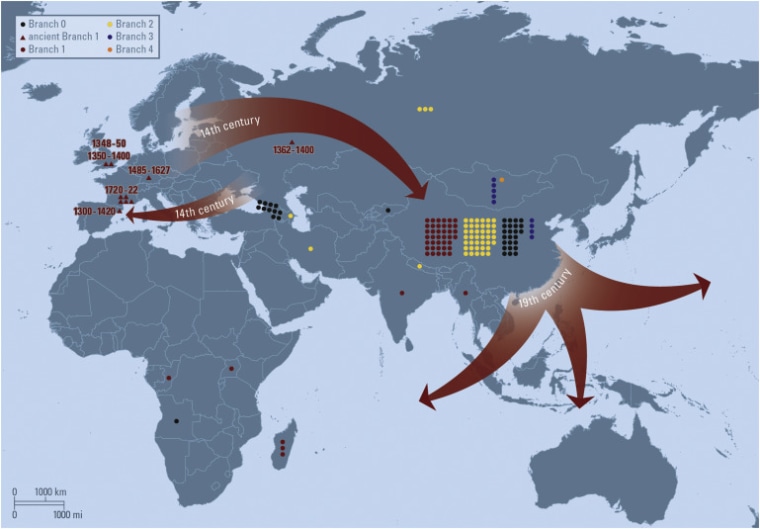It only took one visit for plague – the Black Death – to get a foothold in Europe and kill millions of people over the next 400 years, researchers reported Wednesday.
A team of scientists dug up ancient plague pits from across Europe and then dug into the DNA of some of the victims to build a genetic map of plague.

They found evidence the killer Yersinia pestis bacteria came to Europe just once at the beginning of the medieval period. It hung around for the next 400 years, possibly spreading back eastwards into Asia.
The findings, published in the journal Cell Host & Microbe, counter other theories about how plague came back time and again to claim as much as 60 percent of the population of Europe. Previous theories had held the infection, carried by fleas, was re-introduced several times by travelers from Asia.
“Our results provide support for a single entry of Y. pestis in Europe during the Black Death, (and) a wave of plague that traveled toward Asia to later become the source population for contemporary worldwide epidemics,” Maria Spyrou of the Max Planck Institute for the Science of Human History in German and colleagues wrote in their report.
Related: Plague's Been Killing for 6,000 Years
Doctors make the point over and over that any epidemic of any disease is just a flight away. People carry germs from place to place with them. West Nile virus was never seen in the Western Hemisphere until 1999, when someone or something carried the virus to New York and it spread from Queens to the entire country in just a few years.
“This branch descends directly from the strain circulating in both London and Barcelona during the Black Death.”
Zika virus has traveled around the world from Africa and is currently infecting millions of people in Latin America, the south Pacific and southeast Asia – and a single infected traveler could easily have been the vector.
The same thing happened in medieval times and even earlier. It took a little longer, as travel was on ships, on foot or by horse. But then as now, it only took a single introduction for a new disease to take hold and kill millions.
New, fast genetic sequencing technology makes it possible to compare samples and that’s what Spyrou’s team did. “Samples were collected from a mass grave in Barcelona, Spain, a single grave in Bolgar City in Russia, and a mass grave in Ellwangen, Germany,” they wrote. Plague pits – large mass graves – still exist in many modern cities and the DNA of both the victims and the germs that killed them often survives.
They got plague DNA from 32 victims and compared them to one another and to previous sequences taken by other researchers. DNA mutates at a predictable rate, and it provides kind of a genetic clock that indicates how far apart in space and time two different samples are.
The spring of 1348 was a bad one. An epidemic of plague spread across Europe that year, and the DNA suggests it all came from one source. “We find no detectable differences between our Black Death strain from Barcelona and three previously genotyped strains from London 1348–1350,” the team wrote.
That shows it moved fast across Europe.
“Barcelona was one of the main entry points for the Black Death into Europe, with historical reports suggesting the disease first entered there in the spring of 1348,” the team wrote. “In London, the earliest reports of the illness are from autumn 1348.”
Samples from Germany show the same bug came back to kill 200 years later. “Our plague strain from the German city of Ellwangen is ancestral to those associated with the Great Plague of Marseille (L’Observance), an epidemic that occurred in France some 200 years later,” they wrote.
“This branch descends directly from the strain circulating in both London and Barcelona during the Black Death.”
And a strain sampled in Russia is similar to plague from 14th century London. “The key finding of our study stems from the analysis of an historical Y. pestis strain from the Volga region in Russia,” they wrote.
It supports the idea that plague was carried eastwards from western Europe.
Related: Oregon Girl is 16th Plague Case of 2015
Plague caused by the Yersinia pestis bacteria has infected people for at least 6,000 years. It’s still around, but much more rare now that people know how it’s spread – by fleas that infest rodents. It's not clear where plague first originated, but popular theories suggest it was spread out of central Asia by traders.
"It establishes a link between the Black Death in the mid-14th century and modern plague."
Globally, 1,000 to 2,000 cases are reported to the World Health Organization every year. A few cases are reported every year in the U.S., as well.
Today, it can be treated with antibiotics.
The most common form is bubonic plague – called the Black Death because of the blackened skin and swollen lymph glands called buboes that characterized infection.
Pneumonic plague, an infection of the lungs, can spread from one person to another. It's sometimes spread from animals to people that way, also.
Plague also causes a systemwide infection called septicemic plague. Untreated bubonic and pneumonic plague both can progress to septicemia and that's what usually kills people.
"Our study is the first to provide genetic support for plague's travel from Europe into Asia after the Black Death, and it establishes a link between the Black Death in the mid-14th century and modern plague,” Spyrou said in a statement.
“Evidence is accumulating to support the idea that plague was hiding somewhere locally within Europe for several centuries after the Black Death” added Kirsten Bos, molecular paleopathologist at the Max Planck Institute. "The reasons for its disappearance from Europe, however, remain a mystery."

